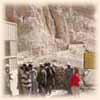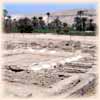










sites/photos
Tomb of Huya
Tomb of Mery-re I
Tomb of Mery-re II
Tomb of Panhesy
City of Amarna
Northern Palace
history
new kingdom
18th Dynasty
Akhenaton
Tutankhamun
hotel
Semiramis
Intercontinental
notes
travelogue
planning
itineraries
tons of photos
chronology
locations
tell-el-amarna
cairo
locations
links
February 22, 2003:
Breakfast was a rather sad affair of cheese and rolls served by an extremely nice team of waiters and the manager, who cut a fine figure in a truly stupendous shamrock green suit coat. We picked up water and the camera and headed to Amarna -- we'd be back for lunch (this is about the only restaurant open to us in the town) and to check out at one or two before the drive back into Cairo. I believe that the requirement that we return to the hotel before leaving for Cairo was proposed by the tourist police as a way to keep track of us. Otherwise, we could have driven straight back on the highway to Cairo. They are all nervous, and it's clear that few tourists venture into Middle Egypt, especially not a lone pair of Americans.
But, as you can see, we weren't alone for long.
Collecting Tourist Police
We crossed the Nile by car ferry and through the
village at El Till on the way to the Northern cemetery
of Amarna, the city of the heretic pharaoh Akhenaton.
On the way to Tell el Amarna, we suddenly collected a dozen people in the van
-- another, different, back-seat Mohammed (yes, his
name really was Mohammed), the local "sheriff", a caretaker and his wife, a stray egyptologist or two,
and another security contingent.
 We had to wait for another escort when we got to the
site, so we sat and had tea while waiting for the
truckload of tourist /military police to show up.
Fateh discussed the history of the sprawling city that once lay in this huge valley
-- and we stared in awe at the complete lack of any
sign of a city here at all. It was gone. Amarna was either completely
buried or completely destroyed by the pharaohs after
Akhenaton and Nefertiti, in an effort to erase their
existence from history. The city was the center of the religious cult for only fifteen years.
We had to wait for another escort when we got to the
site, so we sat and had tea while waiting for the
truckload of tourist /military police to show up.
Fateh discussed the history of the sprawling city that once lay in this huge valley
-- and we stared in awe at the complete lack of any
sign of a city here at all. It was gone. Amarna was either completely
buried or completely destroyed by the pharaohs after
Akhenaton and Nefertiti, in an effort to erase their
existence from history. The city was the center of the religious cult for only fifteen years.
We climbed the stairs to the tombs, followed by our enormous entourage. The carvings and paintings in most of the tombs are defaced, but the style is so different than the "classic" egyptian art that it is worth the walk -- worth the whole trip to Minya and Tel el-Amarna. Most Egyptian art is incredibly formulaic, like engineering drawings or blueprints. It almost makes one think that they were not skilled artists, that they were incapable of depicting real life, or realistic scenes. That is far from the truth, as their sculpture so clearly shows. But two-dimensional drawings are almost ritually formalized, each detail having a well understood symbolic meaning (keep in mind, though, that we are guessing at the meaning and it may all be a big bunch of hooey!)
- feet shown together in statuary or painting signifies that the person is dead
- Left food forward -- alive and warlike
- shown straight ahead, alive
- Curled beard - dead
- Holding an ankh, waset, djet pillar -- royalty
- Cube, sitting, or standing have different meanings
- TYpe of crown signifies war, peacefully uniting the two lands, or which nome was ruled
Amarna art is startlingly modern-looking compared to the rigid depiction of humans in older art. I have to believe that the style is an exaggerated, caricature-like style. It's curvy and full of motion and color. It seems to be smaller, too, with odd perspectives and views of buildings shown. Some appear to be an attempt to show both the front and top of the temple at once, a skewed isometric representation. It is only the inscriptions in the tombs that have allowed archeologists to being to piece together the city.
Amarna Tombs
 The tomb of Mery Re II is the best preserved, with most of the plaster still in place and colors still vivid. In the others, all
the plaster has been chipped off or otherwise defaced. The hands and faces of representations of Akhenaton and Nefertiti are nearly always destroyed, and the symbol of Aten, the sun disk with extended hands, is chipped off and gouged everywhere it appears. The other tombs here, arranged on the cliffside, are filled with scenes of Akhenaton adoring the sun disk, Aten. Most other tombs are scenes of the deceased and his family, but these tombs are adoration of the pharaoh instead. There are four tombs open here: Huya, Meryre I, Meryre II, and Panhesy.
The tomb of Mery Re II is the best preserved, with most of the plaster still in place and colors still vivid. In the others, all
the plaster has been chipped off or otherwise defaced. The hands and faces of representations of Akhenaton and Nefertiti are nearly always destroyed, and the symbol of Aten, the sun disk with extended hands, is chipped off and gouged everywhere it appears. The other tombs here, arranged on the cliffside, are filled with scenes of Akhenaton adoring the sun disk, Aten. Most other tombs are scenes of the deceased and his family, but these tombs are adoration of the pharaoh instead. There are four tombs open here: Huya, Meryre I, Meryre II, and Panhesy.
Amarna Palaces
There is little left of the North or South Palaces, or the enormous Temple to Aten that are described in the tombs. On the plain below the cliffs are the faint outlines of two large palaces. Only the foundations -- somewhat excavated, but it doesn't look like this is a current dig -- show the size and complexity of these buildings. Stone buildings don't disappear that quickly, unless they are dismantled. It's likely that these were, since the Amarna pharaoh Akhenaton was reviled and "erased" by his successors. The outline of a large courtyard, which Fateh explains may have held a pool, can be seen, as well as dozens of smaller rooms.
 I caused a huge fight among a crowd of children by handing a box of Chicklet gum to one of them. He promptly got beaten soundly by a bigger kid. I felt really bad, but Fateh warned us not to give them money, which encouraged them. Still.
I caused a huge fight among a crowd of children by handing a box of Chicklet gum to one of them. He promptly got beaten soundly by a bigger kid. I felt really bad, but Fateh warned us not to give them money, which encouraged them. Still.
Practicing the Princess Wave
At one point, we have 20 people in our group. Security,
guide, caretakers, etc. Even Fateh picked up two extra
Egyptologists and we gave them a ride. We never did a picture that did the group justice.
Front-seat Mohammed and Back-seat Mohammed stay with us -- their job is quite clearly as bodyguards, not general security. When the group of people slowed down, Mark and I kept on ahead...and, looking back at the gaggle milling around the narrow path, we accelerated. We were about forty feet away when the two Mohammeds clattered down after us.
There was some issue between Fateh, the two other Egyptologists, and the guards on the cliffside. I'm not sure what it was about, but assume it had to do with giving rides to his "friends" in our van, or tipping -- Fateh tends to pocket the money for tipping, I think, and not pass it around to the tourist police, as generously as they expect. As soon as he figured out that Mark and I were ok with the baksheesh for the tomb caretakers, he simply stopped doing it, and extended that decision to include the tourist police. We never made an issue of it -- it's a few bucks, no more -- but it obviously annoyed the rest of the people involved in our trip.
We talked to Front-Seat Mohammed on the way down. He's very interested that Mark is ex-military and wanted to know about his service. He's been doing this job for about 6 years ("I'm security! Good bodyguard, ya?") and, despite his pleasant demeanor, takes this very seriously. He asks if we have children, and explains that his mother is trying to find him a wife. At 26, he is ready to settle down and have children of his own. He asked how old I was, and blushed when I expressed surprise that he would ask a woman that. He was surprised that we were 37 -- he though much younger, to not have children yet.
The van has a slow leak in a tire, and Mr. Mohammed and the two officers leave us at the hotel to have lunch while they get it fixed. We have lunch at the hotel again -- fried chicken, of a sort, and pack up for the drive. It takes a good hour to get everything set up, and we can tell that Fateh is a bit anxious to get back; but by now we are comfortable with the fact that things are slower here, so we just sit in the nice cool lobby and wait.
It's a long drive to Cairo and we drop the people we have collected one at a time on the way back. By the time we reach the Semiramis, we are back down to me, Mark, Mr. Mohammad, and Front-Seat Mohammed, who follows us all the way to the hotel.
We skipped dinner again, we're too full to eat.